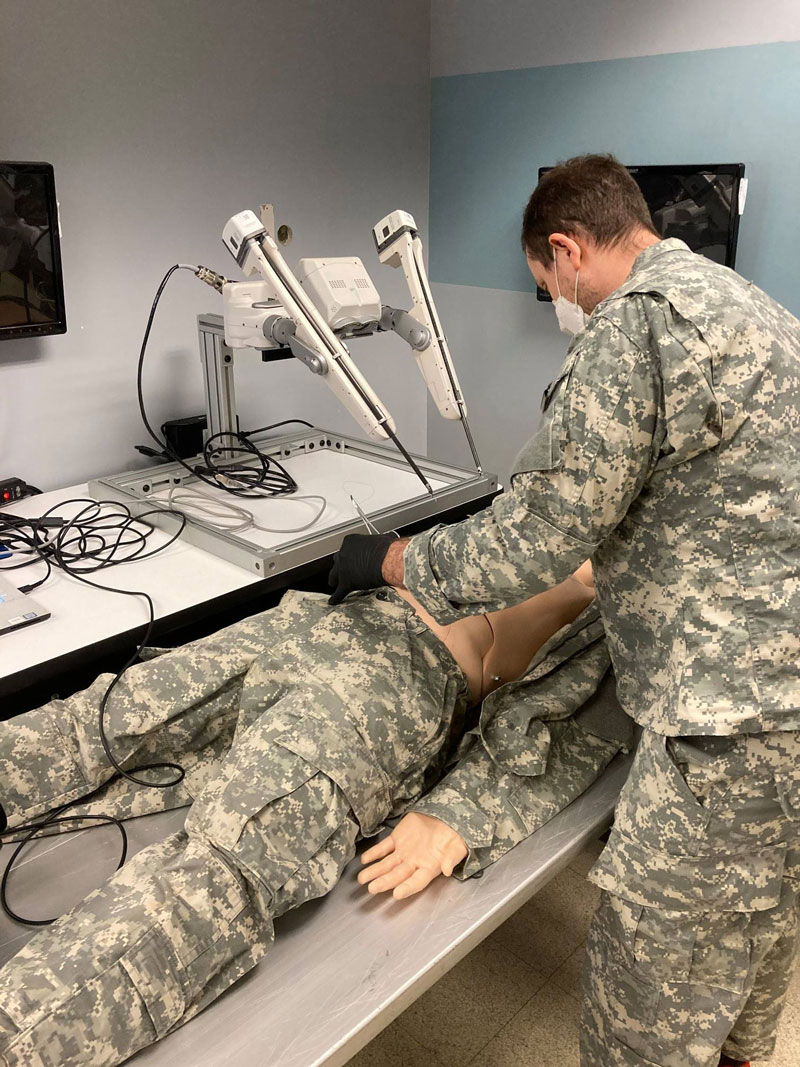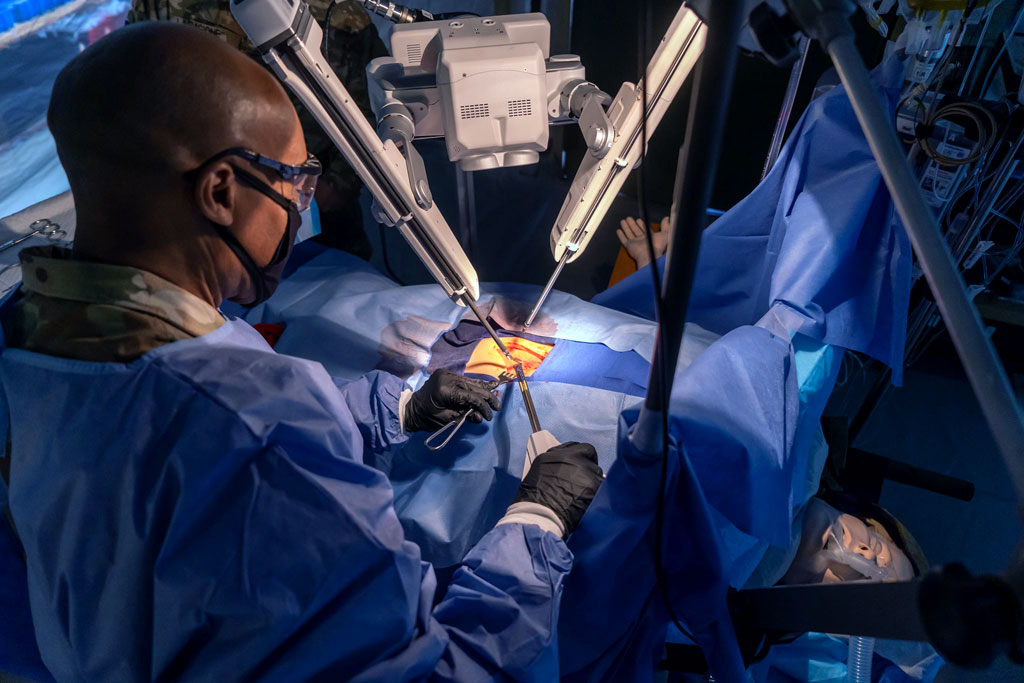TATRC MedRAS Partners with Navy in 1st Ever Telerobotic Surgery Summit
June 30, 2021 | Download PDF

May 2nd marked the Inaugural TeleRobotic Surgery Symposium, a virtual event for Department of Defense stakeholders in Telemedicine, Telementoring, and Telesurgery. The symposium was chaired by CAPT Gordon Wisbach, Staff General Surgeon at the Naval Medical Readiness and Training Command San Diego (NMRTC-SD) and co-chaired by TATRC’s Medical Robotics & Autonomous Systems Division Chief, Mr. Nathan Fisher. Attendees joined virtually from all across the country and from all branches of Military service including representatives from Army Futures Command, NMRTC-SD, Air Force Medical Readiness Agency, Defense Health Agency (DHA), Defense Advanced Research Projects Agency (DARPA), and the Defense Innovation Unit (DIU).
The goal of this inaugural symposium was to foster a community within the DoD with shared, common interests in advancing telesurgery and to begin discussions focused on developing a mutual strategic roadmap for government research teams to advance telehealth capabilities and telerobotic surgery research. A total of twelve guest speakers delivered various presentations throughout the full-day symposium, sharing their own unique perspectives and experiences on researching telehealth within the DoD. TATRC Director, COL Jeremy Pamplin kicked off the symposium describing the history of telesurgery and the challenges we will encounter in the future operating environment, which set up the key questions for the day - “where are we going” and “how do we get there” for telerobotic surgery.
The keynote speaker was Dr. Mehran Anvari, a well-known pioneer and early champion of telerobotic surgery, and the creator of the first telerobotic surgical service between a teaching hospital and a remote site. In his presentation entitled “Tales from a Pioneer in Telesurgery,” Dr. Anvari spoke about the beginnings of telesurgical research and the first successful remote telerobotic procedure he conducted. He continued to explain the challenges of robotic surgery research in the early 2000’s and where the future needs to focus to continue telesurgery research going forward. Dr. Anvari was followed up by MAJ Steve Hong from Walter Reed National Medical Center who presented on the “Current State of Robotic Surgery in DoD.” Dr. Hong detailed the prevalence of robotic surgery and current uses in the Military Health System. He described the growth within both the MHS and the civilian medical sector for surgical robotic platforms and illustrated how the future of hospital robotics is going to be designing the robotics to be smaller and more cost effective.

To answer the “where are we going” portion of the symposium’s mission, Mr. Nathan Fisher presented on the topic of “TeleRobotic Surgery – Technology Landscape and Notional Roadmap.” After detailing a brief history of surgical robotics research and illustrating TATRC’s long history as a partner for many telerobotic surgical research efforts, Mr. Fisher noted that throughout that history there are two major inflection points. The first in the late 90’s with the advancements and fusing of fiber optics with robotic control allowing, for the first time, the possibility of remote telerobotic surgery. The second technology inflection point is happening right now with the advancements of human-machine interfaces, 5G telecommunications technologies, and Artificial Intelligence (AI). That is why it was so important that the DoD hold this symposium at this critical point at the beginning of another momentous time for telerobotic surgery technologies. Mr. Fisher then laid out what the goals and roadmap will be for the DoD in telesurgery. Phase I will establish a foundation within the Military Health System of surgical telementoring capabilities. Dr. Wisbach and NMRTC-SD have already begun work on an IRB-approved telementoring project to launch this phase. Phase II will build the telerobotic surgery infrastructure on top of the foundation of telementoring established in Phase I. Expertise and experience of a surgeon will extend from telementoring into direct remote teleoperation by expanding the existing communication channels and networks for telerobotic surgery. Lastly, Phase III will extend the care of an expert surgeon within the MHS to remote sites in austere and pre-hospital locations by advancing emergent technologies in telecommunications (5G) and AI to alleviate latency barriers and automate assistive surgical behaviors.
To help answer the “how do we get there” portion of the symposium’s mission, CAPT Gordon Wisbach spoke in his “Surgical Telementoring” presentation about his work at the Navy Medical Center in San Diego. In a collaborative project with industry partner, Intuitive Surgical, Dr. Wisbach is developing technologies to extend the expertise of the expert surgeon to remote locations and understaffed care facilities. The brainpower of the telementoring capabilities reside in the brand new Virtual Medical Operations Center (VMOC) within the Navy Medical Center, a first of its kind in the DHA. Serving as a central hub, the VMOC can extend expert care to hundreds of patients by state of the art telemedicine and telementoring technologies. The first steps of the telementoring project are to establish reliable communication with bi-directional audio and 3D video. Then, the goal is to demonstrate effective telestration with virtual tools or ‘ghost tools’ during surgical procedures. Lastly, the telementoring project will develop enhanced capabilities through Machine Learning and analytics. This work, already underway at the NMRTC-SD , marks the start of Phase I of the TeleRobotic Surgery roadmap and the beginnings of foundational work for the path ahead.
The remainder of the symposium was filled with insightful and inspiring presentations from guests all across the DoD and other federal agencies.
The information sharing and networking that occurred during this event fulfilled the first goal of the symposium by helping to foster growth within the DoD community interested in the long-term goal of telerobotic surgery. The next steps are to solidify the Telesurgical roadmap and begin executing Phase I action items, which can start immediately or in some cases are already underway.
“This inaugural symposium is an important first step in establishing a federal ‘Community of Interest’ to define a shared vision and technology development roadmap for TeleRobotic Surgery spanning near, mid, and far term time horizons. Thank you to our distinguished speakers who shared their valuable insights and to the numerous stakeholders in attendance. Working together, we will forge the future for telerobotic surgery to improve surgical care of patients,” stated Mr. Fisher.
A follow on meeting is being planned for the fall of 2021.
For more information on this project, please contact Mr. Nathan Fisher, nathan.t.fisher3.civ@mail.mil.
This article was published in the January 2022 issue of the TATRC Times.